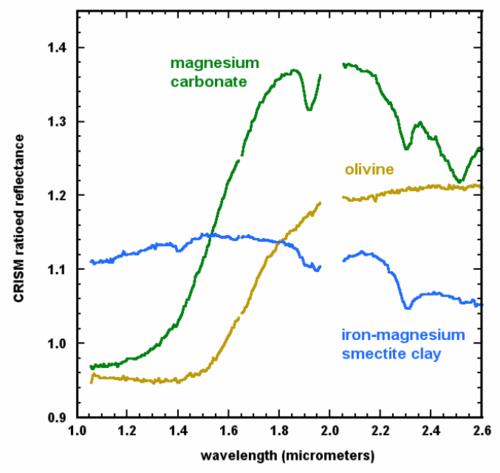Four Types of Deposits From Wet Conditions on Early Mars
Each of these four panels shows a close-up view of a different type of geological deposit formed with the involvement of water, based on observations by NASA's Mars Reconnaissance Orbiter. All four date from the earliest period of Martian history, called the Noachian Period.
The upper-left panel shows carbonates overlying clays in the Nili Fossae region of Mars. The view combines color-coded information from infrared spectral observations by the Compact Reconnaissance Imaging Spectrometer for Mars (CRISM) with an underlying black-and-white image from the High Resolution Imaging Science Experiment (HiRISE) camera. Beneath a rough-textured capping rock unit (purple) lie banded olivine-bearing layers (yellow), which in some places have been partially or wholly altered to carbonate (green).
The upper-right panel shows phyllosilicates and chlorides in the Terra Sirenum region, observed by CRISM and HiRISE. Medium-toned, finely fractured rocks containing chloride salts either underlie higher-standing, light-toned phyllosilicates or fill in low spots between them. Both sit on dark, eroded volcanic material.
The lower-left panel shows the upper portion of canyon wall in Coprates Chasma, observed by HiRISE and CRISM. The chasm rim cuts across the middle of the image. The wall slopes down to the top of the image and continues outside the region shown, exposing multiple phyllosilicate-bearing layers in a section of rock 7 kilometers (4 miles) thick. Two of the layers shown here are finely fractured aluminum clays that dominate the lower half of the image, underlain by thin beds of iron-magnesium clays at the top of the image. The dark material is a remnant of an overlying layer of basaltic sand that has been partly eroded away by the wind.
The lower-right panel shows phyllosilicates with vertically layered compositions in Mawrth Vallis, observed by HiRISE (presented in enhanced color) and CRISM. The brown-colored knob in the middle of the scene is a remnant of cap rock that overlies aluminum clays (blue-gray), which in turn overlie iron-magnesium clays (buff).
Image credit: NASA/JPL/JHUAPL/University of Arizona/Brown University

Mineral Spectra from Nili Fossae, Mars
Spectra collected by the Compact Reconnaissance Imaging Spectrometer for Mars (CRISM) indicate the presence of three distinct minerals. The graphed information comes from an observation of terrain in the Nili Fossae area of northern Mars. CRISM is one of six science instruments on NASA's Mars Reconnaissance Orbiter.
Iron-magnesium smectite clay is formed through alteration of rocks by liquid water and is characterized by distinctive absorptions at 1.4, 1.9, and 2.3 micrometers due to water (H2O) and OH in the atomic structure of the mineral. Olivine is an iron magnesium silicate and primary igneous mineral, and water is not in its structure. Its spectrum is characterized by a strong and broad absorption at 1.0 micrometer due to ferrous iron (Fe2+). Carbonate is an alteration mineral identified by the distinctive paired absorptions at 2.3 and 2.5 micrometers. The precise band positions at 2.31 and 2.51 micrometers identify the carbonate at this location as magnesium carbonate. The broad 1.0 micrometer band indicates some small amount of ferrous iron is also present and the feature at 1.9 micrometers indicates the presence of water. CRISM researchers believe the magnesium carbonate found in the Nili Fossae region formed from alteration of olivine by water.
The data come from a CRISM image catalogued as FRT00003E12. The spectra shown here are five-pixel-by-five-pixel averages of CRISM L-detector spectra taken from three different areas within the image that have then been ratioed to a five-pixel-by-five-pixel common denominator spectrum taken from a spectrally unremarkable area with no distinctive mineralogic signatures. This technique highlights the spectral contrasts between regions due to their unique mineralogy. The spectral wavelengths near 2.0 micrometers are affected by atmospheric absorptions and have been removed for clarity.
Image credit: NASA/JPL/JHUAPL/Brown University
Fin du document
Haut de page
.../...
Abonnés : cliquez ici pour accéder à la suite
Non abonnés : accéder
au micro-paiment à partir de 1,80 €
pour 10 pages , cliquez
ici
pour tout connaître sur
notre offre, cliquez ici





